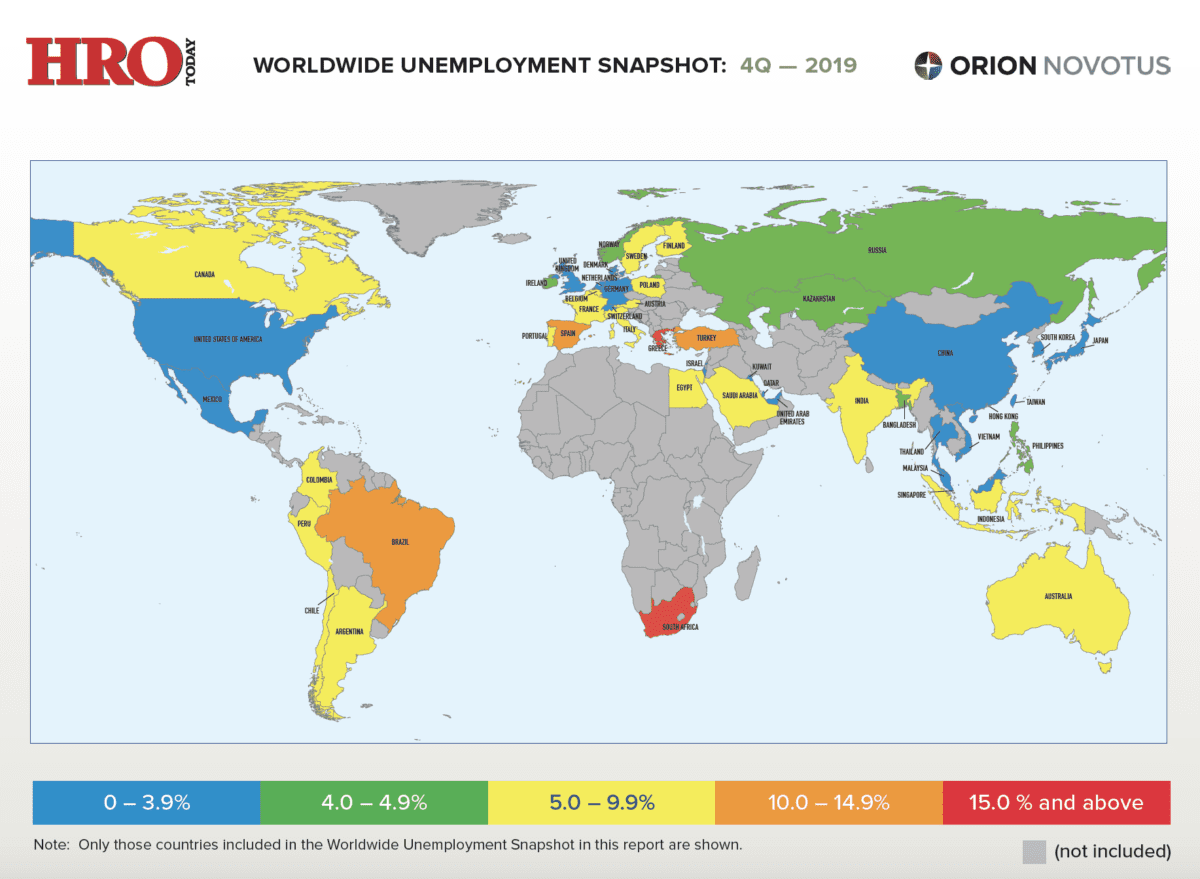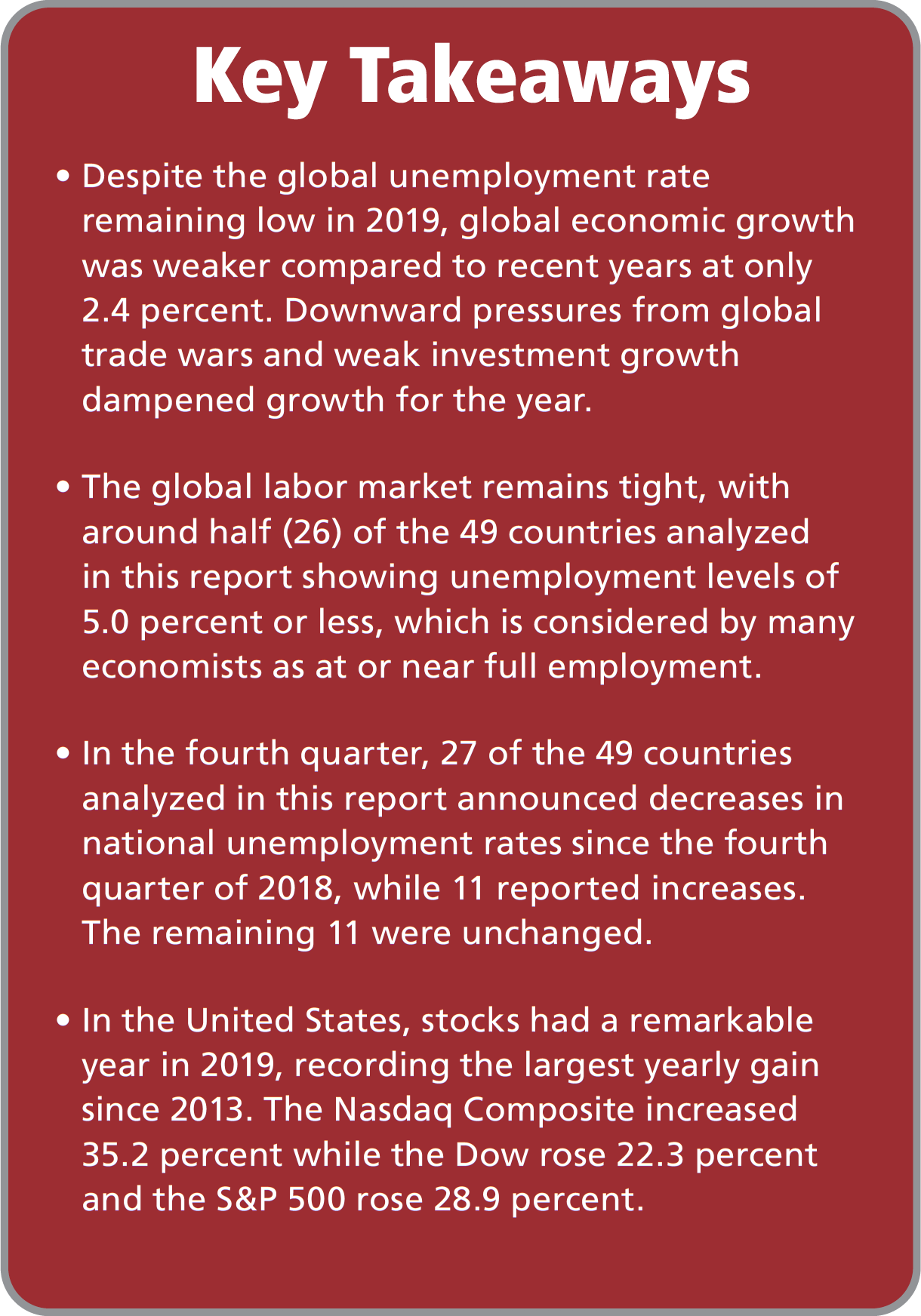Despite economic turmoil largely caused by COVID-19, the overall worldwide employment environment in the final quarter of 2019 was stable.
By Larry Basinait
Deploying a global workforce and ensuring access to the best talent is a crucial component of success for all multinational enterprises. Global labor market intelligence is an invaluable tool for these HR departments and can be used to inform critical decisions around the best countries and regions in which to grow.
To truly understand unemployment rates, it is necessary to collect several categories of market information about the overall economic environment from which they derive. For that reason, this report also analyzes measures that include GDP, economic forecasts, and other factors that offer insight into a given country’s economic circumstances.
In 2019, global economic growth continued to decelerate, stemming from trade wars and weak investment growth which impacted nearly every region of the world. The 2019 economy was highly disrupted by “Phase One” of the United States-China trade negotiations, passed in December 2019, but the World Bank estimates that those disruptions may not continue into 2020. The widespread global challenges affected not only economic growth but also key indicators of economic activity, such as manufacturing, which softened to levels that are approaching those of the 2008 financial crisis. Overall, global growth decreased from 3.0 percent in 2018 to 2.4 percent in 2019.
Despite the slowdown in economic growth, the global labor market remained robust as the unemployment rate in 2019 remained consistent with 2018 levels at 4.9 percent. The World Bank reports that high income countries experienced the largest drop in their unemployment rate from last year, decreasing by 0.2 percentage points to 5.0 percent.

United States and Canada
In the U.S., job creation remained robust, with 184,000 jobs created on average per month in the fourth quarter. In December, the share of women in the workforce outnumbered men for the first time since The Great Recession (2007-2009). Consumer optimism remained relatively high, as reflected in the quarterly average of the Consumer Confidence Index, which currently stands at 126.6. However, wages increased by only 2.9 percent year-over-year in December, which is the lowest growth rate since July of 2018, according to the Bureau of Labor Statistics.
In the fourth quarter, the U.S. unemployment rate dropped to 3.5 percent in 2019, a 0.4 percent decrease from 2018. Historically, unemployment rates at 5.0 percent or lower are considered by many economists to be at or near full employment.
In 2019, all of the major stock indices increased substantially. The Dow Jones industrials increased by 22.3 percent, the S&P 500 increased by 28.9 percent, and the Nasdaq Composite rose by 35.2 percent. Despite the ongoing trade war between U.S. and China, stocks surged on high consumer sentiment and the Federal Reserve cutting interest rates, according to CNBC.
The Canadian unemployment rate in the fourth quarter of 2019 remained consistent with the prior year at 5.6 percent. The Canadian economy ended on a weak note following a rail strike, weakening demand, and a rupture in the Keystone pipeline. In response, the National Bank of Canada reports the Canadian government proposed legislation to lower taxes for nearly 20 million people in order to boost growth and pay off record high household debt.
Asia Pacific (APAC)
 According to FocusEconomics, growth in the East and South Asia (ESA) region slowed in 2019 compared to 2018 and is expected to slow further still in 2020. Trade tensions rattled most of the export-driven markets, causing growth to slump for the year. However, in December, a “Phase One” trade negotiation agreement between the United States and China was reached, stabilizing GDP growth in the fourth quarter. This agreement, along with a dovish stance on monetary policy taken by central banks, should help cushion the economic slowdown in 2020.
According to FocusEconomics, growth in the East and South Asia (ESA) region slowed in 2019 compared to 2018 and is expected to slow further still in 2020. Trade tensions rattled most of the export-driven markets, causing growth to slump for the year. However, in December, a “Phase One” trade negotiation agreement between the United States and China was reached, stabilizing GDP growth in the fourth quarter. This agreement, along with a dovish stance on monetary policy taken by central banks, should help cushion the economic slowdown in 2020.
China has by far the largest economy in the region with a GDP of $13.4 trillion, and is nearly three times larger than the second biggest economy in the region, Japan. Industrial production in December was particularly strong, growing by 6.9 percent on a year-over-year basis, the largest year-over-year increase since February of 2019, according to FocusEconomics. The unemployment rate in China decreased by 0.2 percent since 2018 to 3.6 percent.
Europe, the Middle East, and Africa (EMEA)
The EMEA region covers three continents and includes 116 different countries which vary greatly in GDP and population. Twenty-seven countries in EMEA are tracked in this quarterly analysis. There were mostly positive results in the quarter, with unemployment rates in the overall EMEA region declining year-over-year in 18 of the 27 countries. The country with the biggest decline in unemployment rate on a year-over-year basis was Greece, where the unemployment rate declined by 2.0 percentage points to 16.5 percent. Conversely, South Africa’s unemployment rate increased the most on a year-over-year basis, up 2.0 percentage points to 29.1 percent.
The United Kingdom has the second largest economy in Europe at $2.8 trillion dollars. In the fourth quarter, Brexit uncertainty weighed on the UK economy as manufacturing and services output weakened. Despite the weak economic data, the unemployment rate dropped slightly from 4.0 percent in the fourth quarter of 2018 to 3.8 percent in the fourth quarter of 2019. In 2020, the economy is expected to grow slightly, boosted by the expansionary fiscal stance of the UK government. However, FocusEconomics reports that trade talks with the European Union could pose as a downside risk.
The Middle East and North Africa region is expected to recover in 2020 following a weak 2019. Slowing economic decline in Iran and an expected recovery in oil output could help prospects in 2020, reports FocusEconomics. Egypt, the largest country in the in the region, had the largest drop in unemployment since last year, down 1.1 percent to 7.8 percent. No country in the region had an unemployment rate increase since 2018, with three countries reporting consistent unemployment rates and three countries reporting an unemployment rate decrease.
Latin America
In the fourth quarter of 2019, Latin America’s largest economy, Brazil, reported a drop in its unemployment rate, down 0.6 percent from 2018 to 11.0 percent, the lowest level since March of 2016. Economic activity increased within the quarter, boosted by greater domestic demand led by growth in consumer spending. Nonetheless, exports declined as demand from China and Argentina softened. In 2020, FocusEconomics cites that growth is set to hit a five-year high as high economic sentiment and accommodative monetary policy boost consumer spending and investment.
Mexico is the second largest country in the region, both by GDP and population. Economic growth slowed in the fourth quarter as the manufacturing and the construction industry slumped from a weak third quarter.
Click here to view the entire report, sponsored by Orion Novotus, an Orion Talent company.














